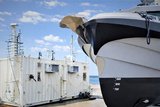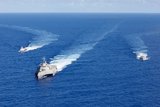DST developing maritime application for SPAD technology
Australia’s Defence and Science Technology (DST) is developing a maritime application for its single-photon avalanche detector (SPAD) technology, the DST announced on 10 April.
The project aims to develop a SPAD sensor and laser system that can be mounted on a gimbal on a hovering UAS tethered above the ocean surface to scan the depths for underwater vehicles and sea mines.
Partly funded by the Royal Australian Air Force’s Plan Jericho, the team has tested the sensor mounted on a wharf, and on a vessel at sea. The team measured the open water transparency using Secchi disks, the disks that are lowered into a water body until no longer visible. This depth of disappearance, called the Secchi depth, is a measure of the transparency of the water.
The SPAD sensors are designed for low-light detection of objects. With 256×256 pixels of resolution, the new version of the SPAD chip will improve the sensor's capability. Two chip layers will be joined together to create an advanced sensor.
Initial trials with a custom-built, heavy-lift, unpiloted multicopter version of the SPAD system were recently conducted over the waters off the South Australian coastline. The next stage of work will focus on optimising optics and image processing.
More from Naval Warfare
-
![Maritime defence in the Mediterranean faces challenges from vulnerable land power]()
Maritime defence in the Mediterranean faces challenges from vulnerable land power
As an indispensable energy crossroads, the Mediterranean is at serious risk from grey zone disruption. As navies increasingly employ AI data centres, what happens when cutting-edge defence technologies rely on the very infrastructure most susceptible to hybrid tactics?
-
![Future Canadian Continental Defence Corvette will provide “Halifax-equivalent capabilities”]()
Future Canadian Continental Defence Corvette will provide “Halifax-equivalent capabilities”
Although the CDC project is still in its early stages, the Canadian Department of National Defence already has some requirements for the future platforms.
-
![US Navy to acquire micro-uncrewed underwater vehicles for ISR and coastal data collection]()
US Navy to acquire micro-uncrewed underwater vehicles for ISR and coastal data collection
The Naval Supply Systems Command is seeking authorised resellers of JaiaBot uncrewed underwater vehicles and multivehicle pods. The platforms will support undergraduate education at the US Naval Academy.





















